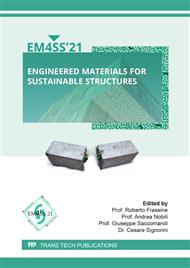[1]
M. V. Sivaselvan and A. M. Reinhorn. Hysteretic models for deteriorating inelastic structures. Journal of Engineering Mechanics, 126(6):633-640, (2000).
DOI: 10.1061/(asce)0733-9399(2000)126:6(633)
Google Scholar
[2]
H. Rodrigues, H. Varum, and A. Costa. Simplified macro-model for infill masonry panels. Journal of Earthquake Engineering, 14(3):390-416, (2010).
DOI: 10.1080/13632460903086044
Google Scholar
[3]
S. Sirotti, M. Pelliciari, F. Di Trapani, B. Briseghella, G. Carlo Marano, C. Nuti, and A. M. Tarantino. Development and validation of new bouc-wen data-driven hysteresis model for masonry infilled rc frames. Journal of Engineering Mechanics, 147(11):04021092, (2021).
DOI: 10.1061/(asce)em.1943-7889.0002001
Google Scholar
[4]
P. G. Asteris, L. Cavaleri, F. Di Trapani, and V. Sarhosis. A macro-modelling approach for the analysis of infilled frame structures considering the effects of openings and vertical loads. Structure and Infrastructure Engineering, 12(5):551-566, (2016).
DOI: 10.1080/15732479.2015.1030761
Google Scholar
[5]
L. Cavaleri and F. Di Trapani. Cyclic response of masonry infilled RC frames: Experimental results and simplified modeling. Soil Dynamics and Earthquake Engineering, 65:224-242, 2014.[6] R. Bouc. A mathematical model for hysteresis. Acta Acustica united with Acustica, 24(1):16-25, (1971).
DOI: 10.1016/j.soildyn.2014.06.016
Google Scholar
[7]
Y. K. Wen. Method for random vibration of hysteretic systems. Journal of Engineering Mechanics, 102(2):249-263, (1976).
Google Scholar
[8]
S. K. Kunnath, J. B. Mander, and L. Fang. Parameter identification for degrading and pinched hysteretic structural concrete systems. Engineering Structures, 19(3):224-232, (1997).
DOI: 10.1016/s0141-0296(96)00058-2
Google Scholar
[9]
X. Wang, X. Lu, and L. Ye. Numerical simulation for the hysteresis behavior of RC columns under cyclic loads. Journal of Engineering Mechanics, 12:017, (2007).
Google Scholar
[10]
C. S. Lee and S. W. Han. Computationally effective and accurate simulation of cyclic behaviour of old reinforced concrete columns. Engineering Structures, 173:892-907, (2018).
DOI: 10.1016/j.engstruct.2018.07.020
Google Scholar
[11]
M. Ismail, J. Rodellar, and F. Ikhouane. An innovative isolation device for aseismic design. Engineering Structures, 32(4):1168-1183, (2010).
DOI: 10.1016/j.engstruct.2009.12.043
Google Scholar
[12]
A. Manzoori and H. Toopchi-Nezhad. Application of an extended Bouc-Wen model in seismic response prediction of unbonded fiber-reinforced isolators. Journal of Earthquake Engineering, 21(1):87-104, (2017).
DOI: 10.1080/13632469.2016.1138166
Google Scholar
[13]
A. E. Charalampakis and C. K. Dimou. Identification of Bouc-Wen hysteretic systems using particle swarm optimization. Computers & Structures, 88(21-22):1197-1205, (2010).
DOI: 10.1016/j.compstruc.2010.06.009
Google Scholar
[14]
S. Y. Kim and C. H. Lee. Description of asymmetric hysteretic behavior based on the Bouc-Wen model and piecewise linear strength-degradation functions. Engineering Structures, 181:181-191, (2019).
DOI: 10.1016/j.engstruct.2018.12.021
Google Scholar
[15]
A. Aloisio, R. Alaggio, J. Köhler, and M. Fragiacomo. Extension of generalized Bouc-Wen hysteresis modeling of wood joints and structural systems. Journal of Engineering Mechanics, 146(3):04020001, (2020).
DOI: 10.1061/(asce)em.1943-7889.0001722
Google Scholar
[16]
N. Vaiana, S. Sessa, F. Marmo, and L. Rosati. A class of uniaxial phenomenological models for simulating hysteretic phenomena in rate-independent mechanical systems and materials. Nonlinear Dynamics, 93(3):1647-1669, (2018).
DOI: 10.1007/s11071-018-4282-2
Google Scholar
[17]
A. Aloisio, M. De Angelo, R. Alaggio, and G. D'Ovidio. Dynamic identification of HTS maglev module for suspended vehicle by using a single-degree-of-freedom generalized Bouc-Wen hysteresis model. Journal of Superconductivity and Novel Magnetism, 34(2):399-407, (2021).
DOI: 10.1007/s10948-020-05745-2
Google Scholar
[18]
M. Pelliciari, B. Briseghella, F. Tondolo, L. Veneziano, C. Nuti, R. Greco, D. Lavorato, and A. M. Tarantino. A degrading Bouc-Wen model for the hysteresis of reinforced concrete structural elements. Structure and Infrastructure Engineering, 16(7):917-930, (2020).
DOI: 10.1080/15732479.2019.1674893
Google Scholar
[19]
G. C. Foliente. Hysteresis modeling of wood joints and structural systems. Journal of Structural Engineering, 121(6):1013-1022, (1995).
DOI: 10.1061/(asce)0733-9445(1995)121:6(1013)
Google Scholar
[20]
G. A. Ortiz, D. A. Alvarez, and D. Bedoya-Ruíz. Identification of Bouc-Wen type models using multi-objective optimization algorithms. Computers & Structures, 114:121-132, (2013).
DOI: 10.1016/j.compstruc.2012.10.016
Google Scholar
[21]
R. H. Sues, S. T. Mau, and Y. K. Wen. Systems identification of degrading hysteretic restoring forces. Journal of Engineering Mechanics, 114(5):833-846, (1988).
DOI: 10.1061/(asce)0733-9399(1988)114:5(833)
Google Scholar
[22]
M. Ye and X. Wang. Parameter estimation of the Bouc-Wen hysteresis model using particle swarm optimization. Smart Materials and Structures, 16(6):2341, 2007.[23] M. Pelliciari, G. C. Marano, T. Cuoghi, B. Briseghella, D. Lavorato, and A. M. Tarantino. Parameter identification of degrading and pinched hysteretic systems using a modified Bouc-Wen model. Structure and Infrastructure Engineering, 14(12):1573-1585, (2018).
DOI: 10.1080/15732479.2018.1469652
Google Scholar
[24]
M. Berry, M. Parrish, and M. Eberhard. Peer structural performance database, user's manual (version 1.0). University of California, Berkeley, (2004).
Google Scholar
[25]
M. Pelliciari and A. M. Tarantino. Equilibrium and Stability of Anisotropic Hyperelastic Graphene Membranes. Journal of Elasticity, 144:169-195, (2021).
DOI: 10.1007/s10659-021-09837-5
Google Scholar
[26]
A. B. Matamoros. Study of drift limits for high-strength concrete columns. University of Illinois at Urbana-Champaign, (1999).
Google Scholar
[27]
S. Watson. Design of reinforced concrete frames of limited ductility. (1989).
Google Scholar
[28]
R. S. Aboutaha and R. I. Machado. Seismic resistance of steel-tubed high-strength reinforcedconcrete columns. Journal of Structural Engineering, 125(5):485-494, (1999).
DOI: 10.1061/(asce)0733-9445(1999)125:5(485)
Google Scholar
[29]
J. H. Thomson and J. W. Wallace. Lateral load behavior of reinforced concrete columns constructed using high-strength materials. Structural Journal, 91(5):605-615, (1994).
DOI: 10.14359/4181
Google Scholar
[30]
H. Bechtoula, S. Kono, and F. Watanabe. Experimental and analytical investigations of seismic performance of cantilever reinforced concrete columns under varying transverse and axial loads. Journal of Asian Architecture and Building Engineering, 4(2):467-474, (2005).
DOI: 10.3130/jaabe.4.467
Google Scholar
[31]
Y. L. Mo and S. J. Wang. Seismic behavior of rc columns with various tie configurations. Journal of Structural Engineering, 126(10):1122-1130, (2000).
DOI: 10.1061/(asce)0733-9445(2000)126:10(1122)
Google Scholar
[32]
M. Saatcioglu and M. Grira. Confinement of reinforced concrete columns with welded reinforced grids. Structural Journal, 96(1):29-39, (1999).
DOI: 10.14359/593
Google Scholar
[33]
H. Takemura. Effect of hysteresis on ductility capacity of reinforced concrete bridge piers. Structural Engineering Journal, JSCE, A, 43:849-848, (1997).
Google Scholar
[34]
M. Kanda. Analytical study on elasto-plastic hysteretic behavior of reinforced concrete members. Transaction of the Japan Concrete Institute, 10:257-264, (1988).
Google Scholar


